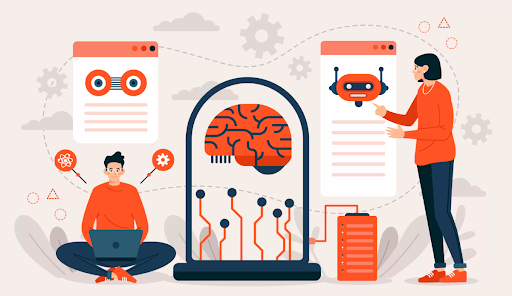How AI and Machine Learning are Revolutionizing the Written Word

In the age of screen-scrolling, written content is one of the most significant sources of knowledge. From looking for today’s news to product descriptions, blocks of text are an essential part of digital content.
As creating compelling written posts can be time-consuming, Artificial Intelligence (AI) comes to revolutionize the creation process. In fact, AI has made tremendous developments in all sectors and industries.
Most notably, AI-powered tools have paved the way for an easier and more effective writing process for brands. Small businesses to big corporates can leverage these tools to elevate their marketing.
With writing tool advancement, writing blog posts, product descriptions, and social media captions can take a minute away. You can also use social media booster tools like Trollishly, HighSocial, TikTribe, and SocialWick to enhance content SEO.
The following discussion will walk you to the future of content writing with AI and machine learning-from generating ideas creating outlines, and producing paragraphs. Let’s jump on to the details!
AI in Content Writing
AI and machine learning have remained to be the backbone of automated content production for the past few years. Their capability stretches from assisting blog production to video creation in mere minutes through simple and specific prompts.
AI writing tools use machine learning to research different writing styles and purposes. Machine learning algorithms enable these tools to learn patterns and rules from vast amounts of data, allowing them to generate written content that closely resembles human-generated text.
However, while AI writing tools have advanced capabilities, they are not yet perfect. The generated text may contain errors, inconsistencies, or lack the creativity and context awareness of a human writer. Therefore, human oversight and editing are often necessary to refine and enhance the output generated by AI writing tools.
Rise of AI in Content Writing
With the growth of online platforms, businesses, marketers, and content creators are under pressure to produce a large volume of content to engage audiences and improve search engine visibility. AI-writing tools provide a solution by automating and streamlining the content creation process.
AI-writing tools can assist human writers in the content creation process. They can generate topic ideas, provide research insights, suggest improvements to existing content, and even help with proofreading and editing. This collaboration between AI and human writers can enhance productivity and creativity in content creation.
The rise of AI in content writing results in numerous writing platforms that offer automated features. Some of the most notable and massively used tools include:
ChatGPT: A language model developed by OpenAI designed to engage in conversational interactions. It can generate responses, answer questions, and provide information.
Jasper AI: A famous AI writing tool writers use to assist content creation, ranging from short social media captions to thousand-word blog posts.
Copy AI: An AI-powered writing tool that focuses on copywriting and marketing. It can assist in generating content for social media, ads, landing pages, product descriptions, and more.
WriterSonic: An AI writing platform that offers various features for content creation. It can generate blog posts, articles, ad copy, landing page content, and social media captions.
Grammarly: A popular AI-powered writing tool that offers grammar and spelling checking and writing style suggestions. To produce error-free content, it provides real-time feedback on errors, clarity, conciseness, tone, and vocabulary usage.
Not stopping there, more and more AI writing assistants are sprouting on the market, including Google Bard. Each of them offers exclusive features to produce accurate and human-like content.
How Does AI Work?

It’s undeniable that most AI-generated text resembles human writing. One of the examples is ChatGPT, an AI content generator that derives high-quality content instantly. To make an AI tool works, it require several factors. Let’s take a look at the three vital aspects in an AI writing tool.
Machine Learning
Machine learning teaches computers to analyze and generate texts. Through organized training, the computer algorithms would know how to generate text based on specific prompts. The results mimic the human style and tone in writing content.
Natural Language Processing
Natural language processing is a technology where computers understand human languages. This technique would break down the paragraphs into sentences so that AI models would understand them. This NLP makes it easy to create coherent and grammatically correct sentences.
Neural Networks
It is a part of machine learning where it makes AI learn complex patterns and then predicts the words or phrases that come next to the sentence or paragraphs. If this network works correctly, there will be a continuous flow of information throughout the article. When the readers read the blogs, they would easily understand the most critical insights.
Examples of AI-Powered Content Creation Tools

AI tools can assist content creation in various industries, including business, creative sectors, education, and journalism. Its widespread adoption and popularity make it one of the most prominent features globally.
There are many tools available on the online platform offering their specialties. We’ve curated three examples of content creation tools based on their primary functions. Let’s have a glance!
1. Paraphrasing Tool
A paraphrasing tool helps writers rephrase or rewrite existing text while maintaining the original meaning. It’s particularly useful when creating content requiring a different wording or avoiding plagiarism.
Paraphrasing tools use advanced natural language processing algorithms to understand the context and structure of the original text and generate alternative versions that retain the core ideas. Users can input the original text, and the tool will provide a paraphrased version instantly.
A popular paraphrasing tool is Quillbot. It utilizes AI algorithms to generate paraphrased content to preserve the original intent while offering alternative phrasing and sentence structure options.
2. Content Generator
A content generator is an AI-powered tool that automates written or visual content creation. It also uses natural language processing techniques to generate text based on the user's specific prompts or parameters.
Content generators are designed to assist with content creation, including blog posts, articles, social media captions, product descriptions, and more. Some examples are ChatGPT, Copy AI, and WriterSonic.
3. Readability Checker
A readability checker is an AI-powered content creation tool that analyzes the readability of text. It helps writers assess the clarity and comprehensibility of their content, ensuring it is accessible to the intended audience.
Readability checkers use linguistic analysis and algorithms to measure sentence length, word complexity, and overall readability scores. The tool provides suggestions for improving readability, such as breaking up long sentences, simplifying complex vocabulary, or adjusting the structure of the text.
An example of a readability checker tool is Hemingway Editor. It highlights complex sentences, excessive adverbs, and other readability issues in different colors, making it easier for writers to identify areas that need improvement.
4. Keyword Analytics and Generator:
Keyword analytics and generator tools assist in identifying relevant keywords for SEO and content optimization. These tools use AI algorithms to analyze search trends, search volume, competition, and other keyword-related factors.
They provide insights into which keywords are popular and can help content creators and marketers optimize their content to rank higher in search engine results. Additionally, keyword generator tools suggest related keywords or long-tail variations that target specific audiences or niches.
The Future of Content Writing and AI:
The AI sector is experiencing rapid expansion, and its growth is expected to continue at an accelerated pace. The integration of AI in content writing will become increasingly prevalent.
Content writers will increasingly rely on AI-powered tools to create more personalized and creative content. These technological advancement trends are reshaping the digital marketing landscape, paving the way for increased audience engagement and satisfaction.
AI tools are also available to enhance social media marketing. They assist in managing multiple social media accounts and optimizing social media marketing efforts by providing a centralized dashboard.
Users can schedule and publish content, engage with their audience, monitor social media performance, and analyze key metrics. Trollishly is an example of an AI-powered social media management tool that provides features and insights to boost content performance on TikTok, Instagram, Facebook, etc.
Wrapping Up
AI and machine learning have undeniably ushered in a new era for the written word, revolutionizing how we create and consume content. Tools such as paraphrasing tools, article rewriters, readability checkers, content generators, and keyword analytics platforms have become indispensable in various industries.
These tools save time, enhance productivity, and help optimize content for better reach and engagement. As technology advances, the future of writing holds immense potential to produce human-like content. Embracing AI and machine learning in writing opens up exciting possibilities, enabling us to create high-quality content that resonates with a specific purpose or group audience.